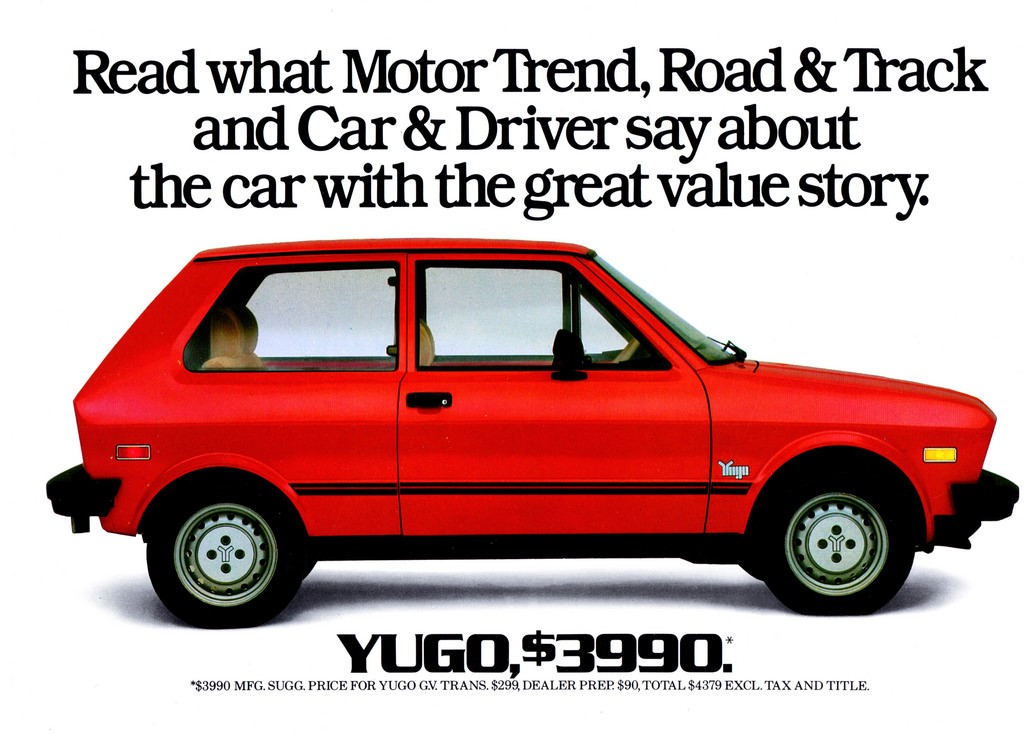The Yugo. Just the name conjures images of automotive mishaps and comedic fodder. Born in Yugoslavia, this compact car etched its place in American consciousness not for its reliability or style, but as the quintessential symbol of automotive failure. Its legacy outlived its road presence, becoming a punchline for comedians long after it vanished from dealerships.
The Rise and Precipitous Fall of Automotive’s Underdog

The Yugo’s journey to becoming arguably the most ridiculed vehicle in the United States is a story ripe with irony and missteps. Jason Vuic meticulously chronicles this saga in his book, “The Yugo: The Rise and Fall of the Worst Car in History,” detailing how an unlikely alliance of capitalist entrepreneurs and cash-strapped Yugoslavian communists gave birth to this automotive legend—for all the wrong reasons. What could have been a symbol of Cold War-era international cooperation instead became a cautionary tale the moment consumers and car critics experienced the Yugo firsthand. Vuic’s narrative dissects the numerous missteps and key players involved in the Yugo venture with sharp wit and journalistic precision, making it a compelling read for anyone fascinated by automotive history or the nostalgia of the 1980s.
Malcolm Bricklin: The Visionary (or Huckster?) Behind Yugo’s American Dream
Every compelling story has a central figure, and in Vuic’s Yugo chronicle, that figure is Malcolm Bricklin. This entrepreneur built his career on importing small, unconventional cars to the American market. Vuic paints Bricklin as a charismatic, larger-than-life personality, a master marketer thriving in the excessive 1980s. His penchant for grand marketing schemes was only rivaled by his love for extravagant displays of wealth. The book meticulously traces Bricklin’s career leading up to the Yugo deal, from his early involvement as a co-founder of Subaru of America (in a venture to import the Subaru 360 minicar!) to his controversial attempt to secure government funding from New Brunswick for his Bricklin SV-1 “safety” sports car project.
The Allure of Affordable Compact Cars in the American Market
Bricklin’s automotive endeavors, though diverse in companies and locations, consistently revolved around a central theme: introducing an affordable, compact car to the American market. At the time, the US auto landscape was dominated by large, gas-guzzling V-8 sedans. While it’s tempting to imagine Bricklin’s focus on smaller, economical cars as potentially pioneering a larger compact car segment in the US, Vuic’s detailed account of Bricklin’s numerous business dealings reveals a man perhaps more captivated by flashy marketing and his opulent lifestyle than a genuine commitment to affordable transportation for the masses.
Zastava Motors and the Collision of Cultures
In stark contrast to Bricklin’s flamboyant and often manipulative approach, the Yugoslavian side, represented by Zastava Motors, is depicted as bureaucratic, lacking in marketing savvy, and accustomed to the sheltered environment of a closed market. Despite being a communist nation, Yugoslavia maintained a unique position, not aligned with the Soviet Union and receiving substantial financial support from the United States during the Cold War. This geopolitical context even led to figures like diplomat Laurence Eagleburger supporting the Yugo’s entry into the US market. Manufactured by the state-owned Zastava Motors, the Yugo itself was essentially a re-packaged, slightly outdated version of the Fiat 127. This dated design, combined with Yugoslavia’s low manufacturing costs, allowed the car to be priced at a mere $3990 in the US, promising substantial profit margins. However, Vuic highlights how Zastava’s fundamental misunderstanding of open capitalist market dynamics ultimately undermined this opportunity. Concepts like dealer commissions and expensive advertising campaigns baffled even senior Zastava officials, leading to significant culture clashes and mutual suspicion between Zastava’s Yugoslavian workforce and Bricklin’s Yugo America team.
The Unraveling: What Became of the Yugo Dream?
The Demise of Yugo America and Zastava’s Fate
The book maintains a light, almost comedic tone throughout, until the final chapter, which takes a somber turn, detailing the aftermath of Yugo America’s collapse and Zastava’s fate during the brutal Yugoslavian Civil War. The narrative shifts to the harsh realities faced by Zastava workers: mass layoffs, the violent disintegration of Yugoslavia into warring factions, ethnic cleansing under Slobodan Milosevic, and the tragic bombing of the Zastava factory, leaving mangled Yugo remains scattered amidst the destruction. The initial promise of the Yugo as a revenue source and a symbol of national pride is utterly shattered as Vuic portrays the desperation and impoverishment of the factory workers in Serbia, where Zastava was located, under Milosevic’s regime.
“Yugo-nostalgia” and the Final Curtain for the Yugo
Even after Milosevic’s removal from power, Zastava never truly recovered. In a move to inject capital into Serbia’s struggling economy, the plant was eventually sold to Fiat in 2008. Serbians were left with only “Yugo-nostalgia,” a bittersweet longing for their past within a unified Yugoslavia. The book concludes with the poignant lyrics of a popular Serbian song reflecting on a time when seemingly everyone owned a Yugo. This melancholic ending prompts reflection on what could have been, leaving the reader to ponder if Yugoslavia, as a unified nation, could have successfully navigated the transition to the modern world, with Zastava potentially becoming a symbol of national industrial pride. After all, as the article suggests, if American consumers granted second chances to early, less-than-stellar offerings from brands like Subaru and Hyundai, perhaps Zastava, and the Yugo, could have also found a path to redemption in the automotive market.
Exploring More Automotive Fiascos
Intrigued by tales of automotive missteps and outright failures? Explore these resources for deeper dives into other spectacularly bad cars throughout history.